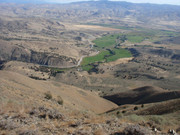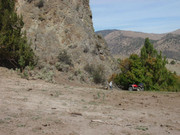Dave
Well-known member
The temperature was finally low enough and the humidity high enough to run the quads up to the back of the property without starting a fire. The road (using the term very loosely) was sure steep and rough. Not one to take a pickup up on. I did see a big flock of Blue Grouse on the way up the hill. So add another species of wildlife to my list. I took a couple pictures from the top looking down on the place. The barn roof is the only thing that shows well. The trees in the yard block the view of the house. The picture doesn't do justice to just how steep it is. If you were to trip where was when taking the pictures you wouldn't quit rolling for a week.



